Essay: Motivation, Performance and Employee Management Strategies
VerifiedAdded on 2023/01/23
|12
|4428
|82
Essay
AI Summary
This essay provides a critical review of several journal articles focusing on the relationship between motivation and performance in organizational settings. The analysis begins by examining the impact of rewards on employee performance, exploring both extrinsic and intrinsic motivational factors. The essay then delves into the significance of performance appraisals and their influence on job satisfaction and employee motivation. Furthermore, it explores the role of talent management in fostering high performance, emphasizing the importance of employee well-being, motivation, and commitment. The review also highlights the impact of high employee involvement on work outcomes and employee satisfaction, as well as the relationship between high and low performers, motivation, and commitment. The essay compares the concepts of performance appraisal and talent management, emphasizing the need for a holistic approach to enhance employee performance and motivation. The articles discussed in this essay provide valuable insights into various strategies and factors that affect employee motivation and performance within organizations.
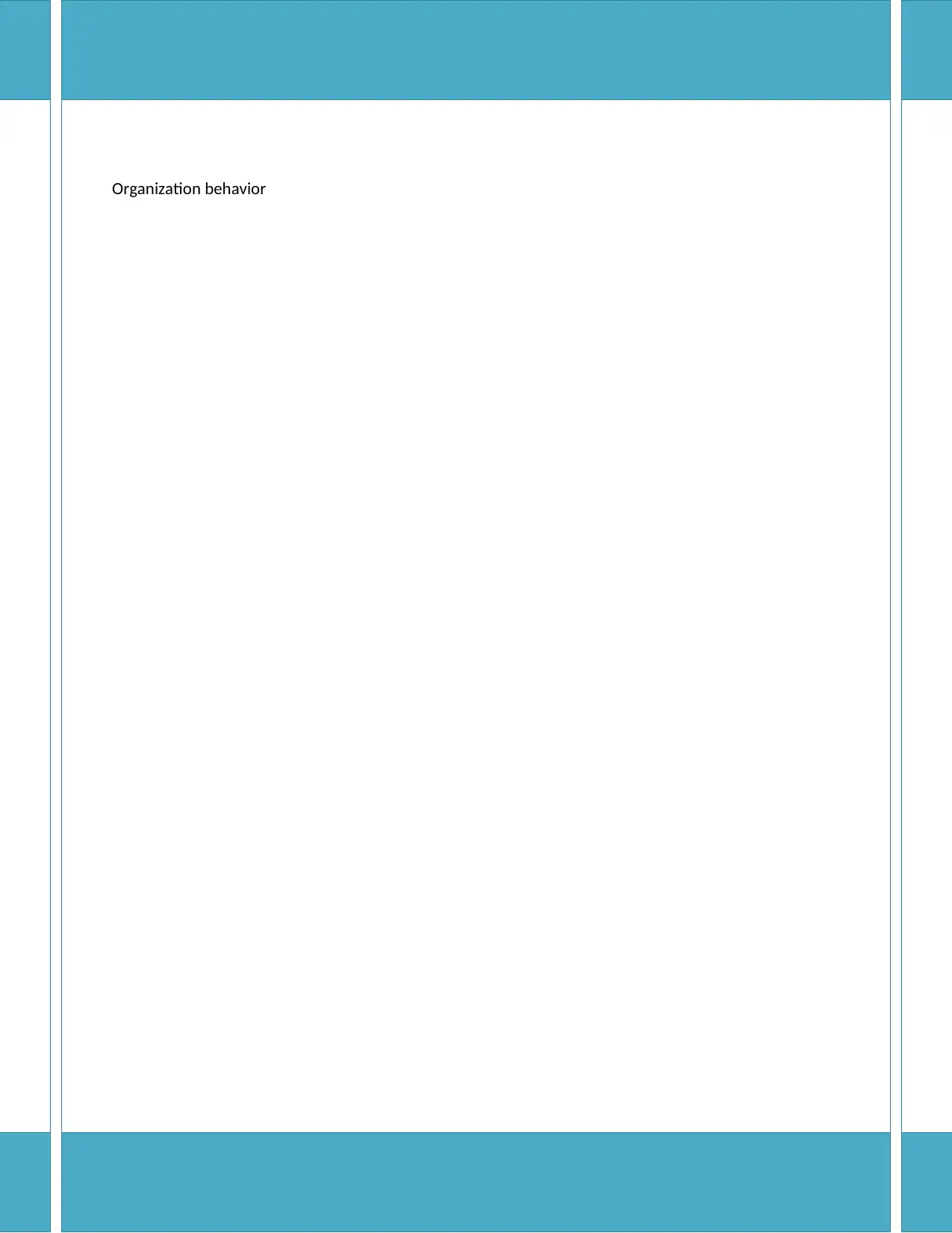
Organization behavior
Paraphrase This Document
Need a fresh take? Get an instant paraphrase of this document with our AI Paraphraser
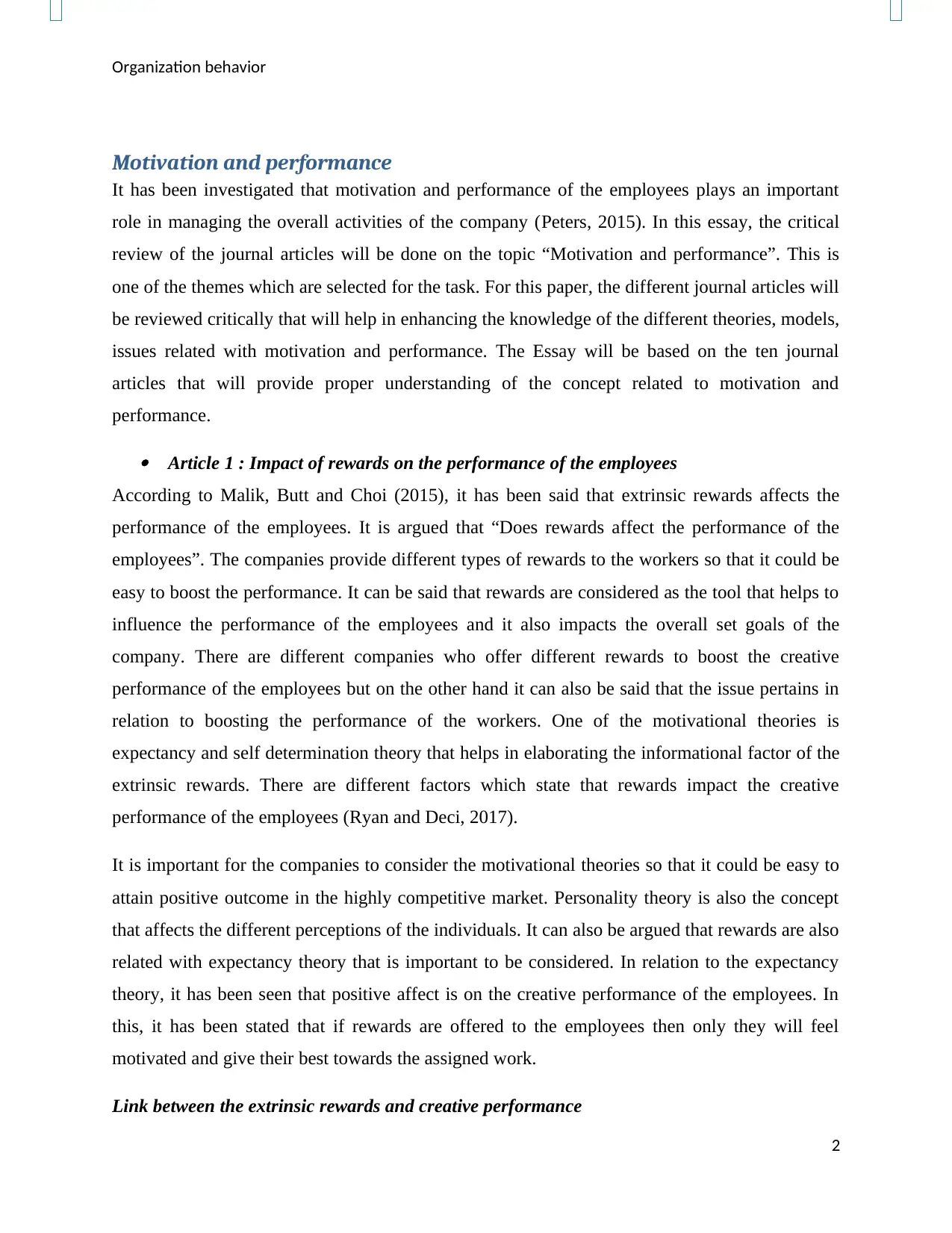
Organization behavior
Motivation and performance
It has been investigated that motivation and performance of the employees plays an important
role in managing the overall activities of the company (Peters, 2015). In this essay, the critical
review of the journal articles will be done on the topic “Motivation and performance”. This is
one of the themes which are selected for the task. For this paper, the different journal articles will
be reviewed critically that will help in enhancing the knowledge of the different theories, models,
issues related with motivation and performance. The Essay will be based on the ten journal
articles that will provide proper understanding of the concept related to motivation and
performance.
Article 1 : Impact of rewards on the performance of the employees
According to Malik, Butt and Choi (2015), it has been said that extrinsic rewards affects the
performance of the employees. It is argued that “Does rewards affect the performance of the
employees”. The companies provide different types of rewards to the workers so that it could be
easy to boost the performance. It can be said that rewards are considered as the tool that helps to
influence the performance of the employees and it also impacts the overall set goals of the
company. There are different companies who offer different rewards to boost the creative
performance of the employees but on the other hand it can also be said that the issue pertains in
relation to boosting the performance of the workers. One of the motivational theories is
expectancy and self determination theory that helps in elaborating the informational factor of the
extrinsic rewards. There are different factors which state that rewards impact the creative
performance of the employees (Ryan and Deci, 2017).
It is important for the companies to consider the motivational theories so that it could be easy to
attain positive outcome in the highly competitive market. Personality theory is also the concept
that affects the different perceptions of the individuals. It can also be argued that rewards are also
related with expectancy theory that is important to be considered. In relation to the expectancy
theory, it has been seen that positive affect is on the creative performance of the employees. In
this, it has been stated that if rewards are offered to the employees then only they will feel
motivated and give their best towards the assigned work.
Link between the extrinsic rewards and creative performance
2
Motivation and performance
It has been investigated that motivation and performance of the employees plays an important
role in managing the overall activities of the company (Peters, 2015). In this essay, the critical
review of the journal articles will be done on the topic “Motivation and performance”. This is
one of the themes which are selected for the task. For this paper, the different journal articles will
be reviewed critically that will help in enhancing the knowledge of the different theories, models,
issues related with motivation and performance. The Essay will be based on the ten journal
articles that will provide proper understanding of the concept related to motivation and
performance.
Article 1 : Impact of rewards on the performance of the employees
According to Malik, Butt and Choi (2015), it has been said that extrinsic rewards affects the
performance of the employees. It is argued that “Does rewards affect the performance of the
employees”. The companies provide different types of rewards to the workers so that it could be
easy to boost the performance. It can be said that rewards are considered as the tool that helps to
influence the performance of the employees and it also impacts the overall set goals of the
company. There are different companies who offer different rewards to boost the creative
performance of the employees but on the other hand it can also be said that the issue pertains in
relation to boosting the performance of the workers. One of the motivational theories is
expectancy and self determination theory that helps in elaborating the informational factor of the
extrinsic rewards. There are different factors which state that rewards impact the creative
performance of the employees (Ryan and Deci, 2017).
It is important for the companies to consider the motivational theories so that it could be easy to
attain positive outcome in the highly competitive market. Personality theory is also the concept
that affects the different perceptions of the individuals. It can also be argued that rewards are also
related with expectancy theory that is important to be considered. In relation to the expectancy
theory, it has been seen that positive affect is on the creative performance of the employees. In
this, it has been stated that if rewards are offered to the employees then only they will feel
motivated and give their best towards the assigned work.
Link between the extrinsic rewards and creative performance
2
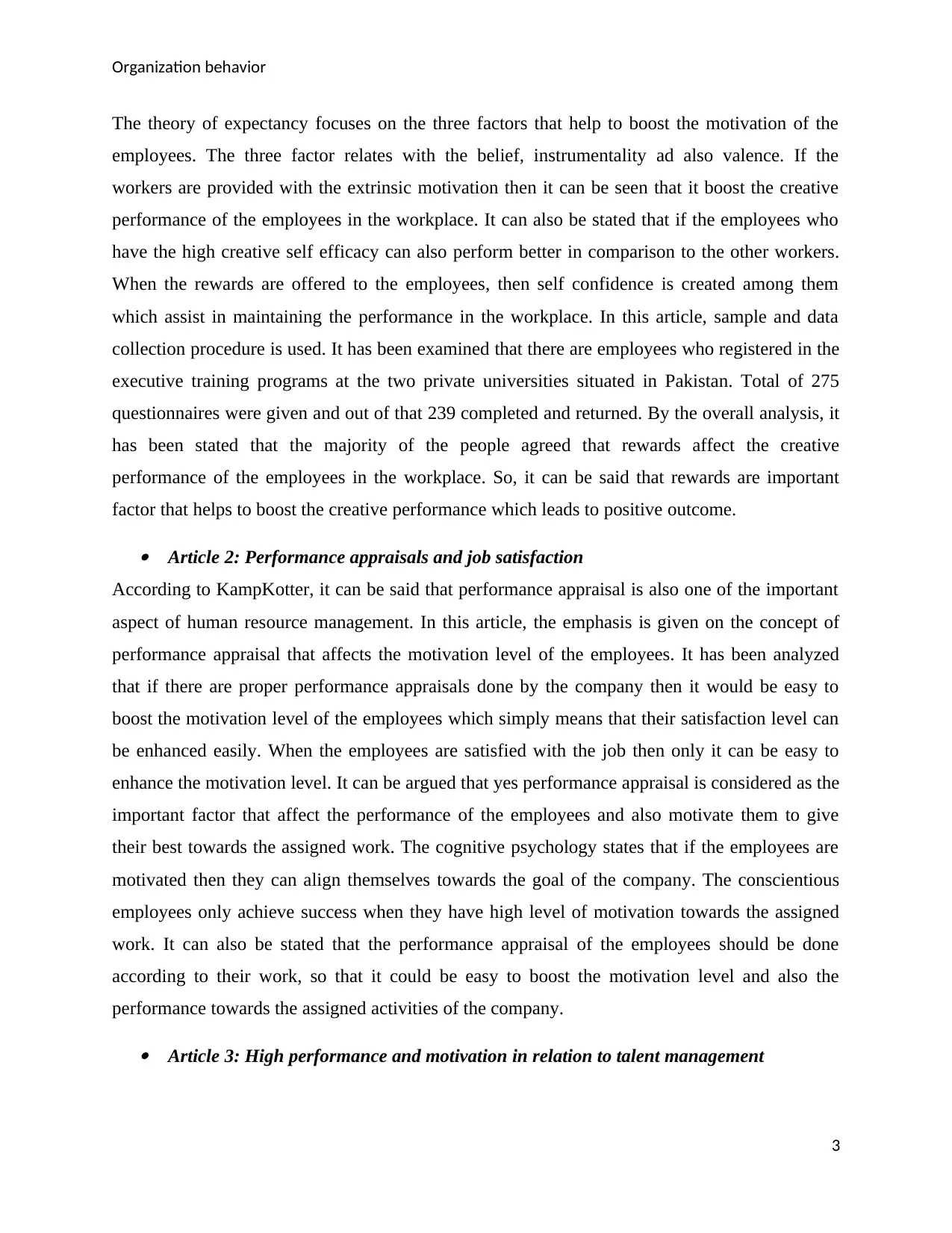
Organization behavior
The theory of expectancy focuses on the three factors that help to boost the motivation of the
employees. The three factor relates with the belief, instrumentality ad also valence. If the
workers are provided with the extrinsic motivation then it can be seen that it boost the creative
performance of the employees in the workplace. It can also be stated that if the employees who
have the high creative self efficacy can also perform better in comparison to the other workers.
When the rewards are offered to the employees, then self confidence is created among them
which assist in maintaining the performance in the workplace. In this article, sample and data
collection procedure is used. It has been examined that there are employees who registered in the
executive training programs at the two private universities situated in Pakistan. Total of 275
questionnaires were given and out of that 239 completed and returned. By the overall analysis, it
has been stated that the majority of the people agreed that rewards affect the creative
performance of the employees in the workplace. So, it can be said that rewards are important
factor that helps to boost the creative performance which leads to positive outcome.
Article 2: Performance appraisals and job satisfaction
According to KampKotter, it can be said that performance appraisal is also one of the important
aspect of human resource management. In this article, the emphasis is given on the concept of
performance appraisal that affects the motivation level of the employees. It has been analyzed
that if there are proper performance appraisals done by the company then it would be easy to
boost the motivation level of the employees which simply means that their satisfaction level can
be enhanced easily. When the employees are satisfied with the job then only it can be easy to
enhance the motivation level. It can be argued that yes performance appraisal is considered as the
important factor that affect the performance of the employees and also motivate them to give
their best towards the assigned work. The cognitive psychology states that if the employees are
motivated then they can align themselves towards the goal of the company. The conscientious
employees only achieve success when they have high level of motivation towards the assigned
work. It can also be stated that the performance appraisal of the employees should be done
according to their work, so that it could be easy to boost the motivation level and also the
performance towards the assigned activities of the company.
Article 3: High performance and motivation in relation to talent management
3
The theory of expectancy focuses on the three factors that help to boost the motivation of the
employees. The three factor relates with the belief, instrumentality ad also valence. If the
workers are provided with the extrinsic motivation then it can be seen that it boost the creative
performance of the employees in the workplace. It can also be stated that if the employees who
have the high creative self efficacy can also perform better in comparison to the other workers.
When the rewards are offered to the employees, then self confidence is created among them
which assist in maintaining the performance in the workplace. In this article, sample and data
collection procedure is used. It has been examined that there are employees who registered in the
executive training programs at the two private universities situated in Pakistan. Total of 275
questionnaires were given and out of that 239 completed and returned. By the overall analysis, it
has been stated that the majority of the people agreed that rewards affect the creative
performance of the employees in the workplace. So, it can be said that rewards are important
factor that helps to boost the creative performance which leads to positive outcome.
Article 2: Performance appraisals and job satisfaction
According to KampKotter, it can be said that performance appraisal is also one of the important
aspect of human resource management. In this article, the emphasis is given on the concept of
performance appraisal that affects the motivation level of the employees. It has been analyzed
that if there are proper performance appraisals done by the company then it would be easy to
boost the motivation level of the employees which simply means that their satisfaction level can
be enhanced easily. When the employees are satisfied with the job then only it can be easy to
enhance the motivation level. It can be argued that yes performance appraisal is considered as the
important factor that affect the performance of the employees and also motivate them to give
their best towards the assigned work. The cognitive psychology states that if the employees are
motivated then they can align themselves towards the goal of the company. The conscientious
employees only achieve success when they have high level of motivation towards the assigned
work. It can also be stated that the performance appraisal of the employees should be done
according to their work, so that it could be easy to boost the motivation level and also the
performance towards the assigned activities of the company.
Article 3: High performance and motivation in relation to talent management
3
⊘ This is a preview!⊘
Do you want full access?
Subscribe today to unlock all pages.

Trusted by 1+ million students worldwide
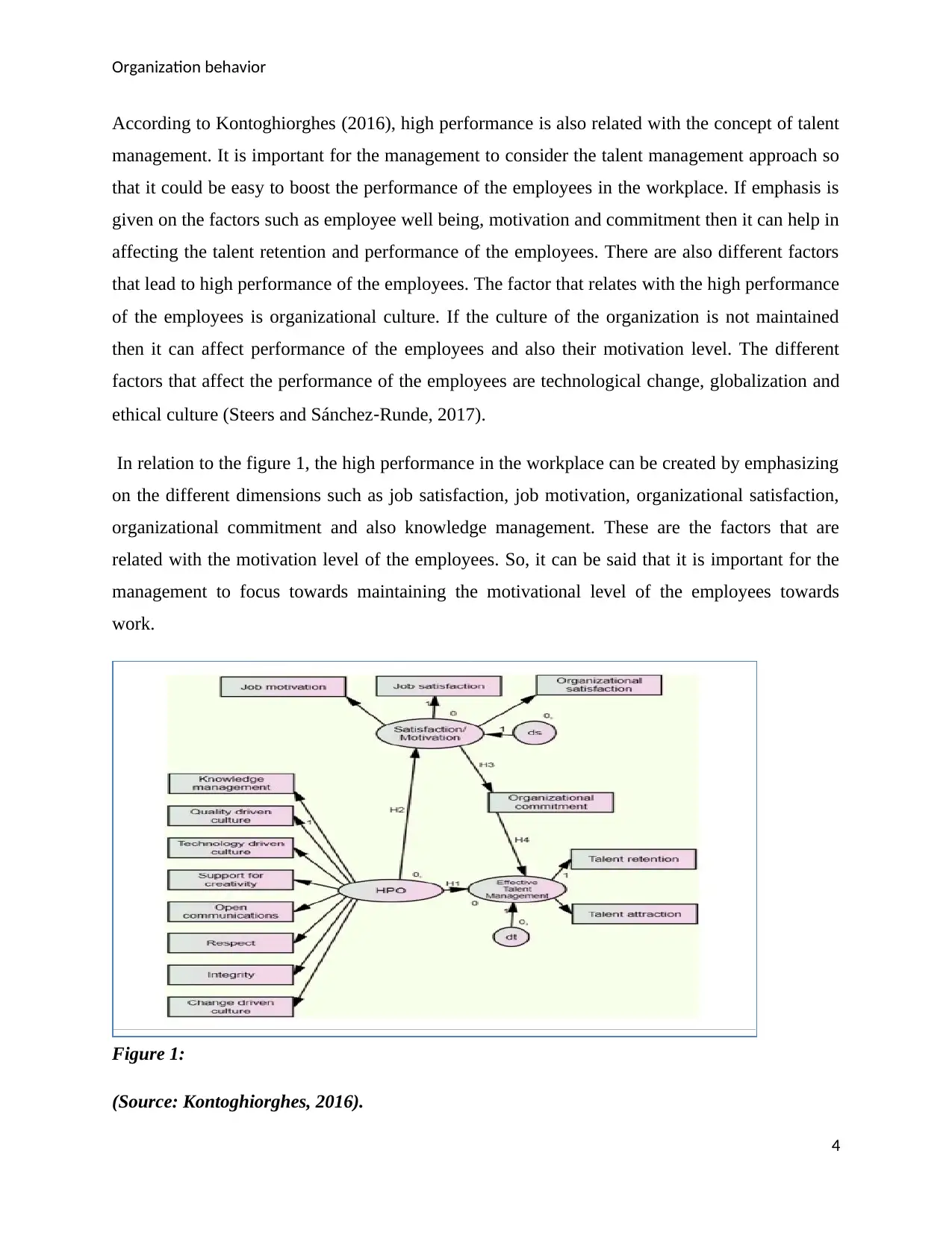
Organization behavior
According to Kontoghiorghes (2016), high performance is also related with the concept of talent
management. It is important for the management to consider the talent management approach so
that it could be easy to boost the performance of the employees in the workplace. If emphasis is
given on the factors such as employee well being, motivation and commitment then it can help in
affecting the talent retention and performance of the employees. There are also different factors
that lead to high performance of the employees. The factor that relates with the high performance
of the employees is organizational culture. If the culture of the organization is not maintained
then it can affect performance of the employees and also their motivation level. The different
factors that affect the performance of the employees are technological change, globalization and
ethical culture (Steers and Sánchez‐Runde, 2017).
In relation to the figure 1, the high performance in the workplace can be created by emphasizing
on the different dimensions such as job satisfaction, job motivation, organizational satisfaction,
organizational commitment and also knowledge management. These are the factors that are
related with the motivation level of the employees. So, it can be said that it is important for the
management to focus towards maintaining the motivational level of the employees towards
work.
Figure 1:
(Source: Kontoghiorghes, 2016).
4
According to Kontoghiorghes (2016), high performance is also related with the concept of talent
management. It is important for the management to consider the talent management approach so
that it could be easy to boost the performance of the employees in the workplace. If emphasis is
given on the factors such as employee well being, motivation and commitment then it can help in
affecting the talent retention and performance of the employees. There are also different factors
that lead to high performance of the employees. The factor that relates with the high performance
of the employees is organizational culture. If the culture of the organization is not maintained
then it can affect performance of the employees and also their motivation level. The different
factors that affect the performance of the employees are technological change, globalization and
ethical culture (Steers and Sánchez‐Runde, 2017).
In relation to the figure 1, the high performance in the workplace can be created by emphasizing
on the different dimensions such as job satisfaction, job motivation, organizational satisfaction,
organizational commitment and also knowledge management. These are the factors that are
related with the motivation level of the employees. So, it can be said that it is important for the
management to focus towards maintaining the motivational level of the employees towards
work.
Figure 1:
(Source: Kontoghiorghes, 2016).
4
Paraphrase This Document
Need a fresh take? Get an instant paraphrase of this document with our AI Paraphraser
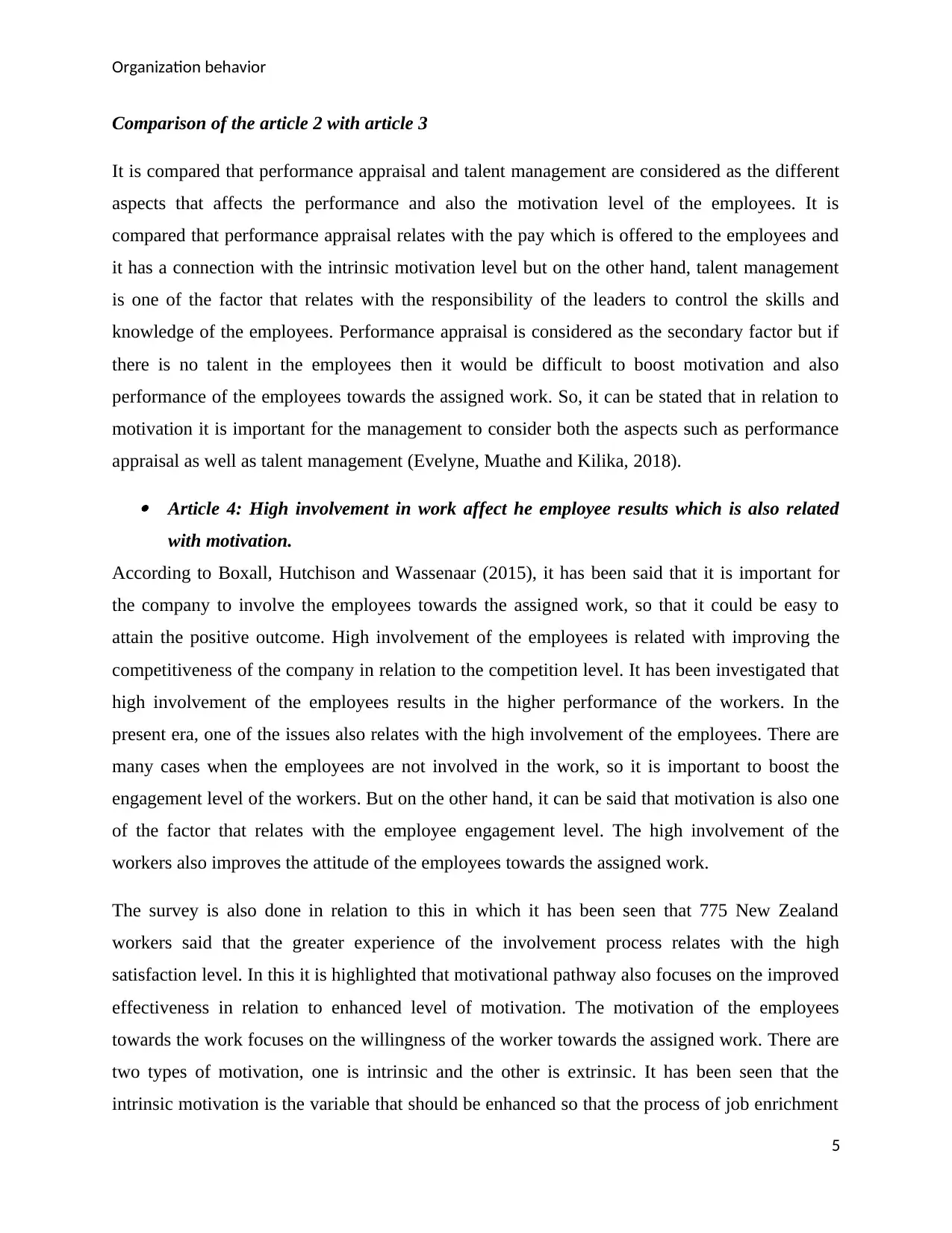
Organization behavior
Comparison of the article 2 with article 3
It is compared that performance appraisal and talent management are considered as the different
aspects that affects the performance and also the motivation level of the employees. It is
compared that performance appraisal relates with the pay which is offered to the employees and
it has a connection with the intrinsic motivation level but on the other hand, talent management
is one of the factor that relates with the responsibility of the leaders to control the skills and
knowledge of the employees. Performance appraisal is considered as the secondary factor but if
there is no talent in the employees then it would be difficult to boost motivation and also
performance of the employees towards the assigned work. So, it can be stated that in relation to
motivation it is important for the management to consider both the aspects such as performance
appraisal as well as talent management (Evelyne, Muathe and Kilika, 2018).
Article 4: High involvement in work affect he employee results which is also related
with motivation.
According to Boxall, Hutchison and Wassenaar (2015), it has been said that it is important for
the company to involve the employees towards the assigned work, so that it could be easy to
attain the positive outcome. High involvement of the employees is related with improving the
competitiveness of the company in relation to the competition level. It has been investigated that
high involvement of the employees results in the higher performance of the workers. In the
present era, one of the issues also relates with the high involvement of the employees. There are
many cases when the employees are not involved in the work, so it is important to boost the
engagement level of the workers. But on the other hand, it can be said that motivation is also one
of the factor that relates with the employee engagement level. The high involvement of the
workers also improves the attitude of the employees towards the assigned work.
The survey is also done in relation to this in which it has been seen that 775 New Zealand
workers said that the greater experience of the involvement process relates with the high
satisfaction level. In this it is highlighted that motivational pathway also focuses on the improved
effectiveness in relation to enhanced level of motivation. The motivation of the employees
towards the work focuses on the willingness of the worker towards the assigned work. There are
two types of motivation, one is intrinsic and the other is extrinsic. It has been seen that the
intrinsic motivation is the variable that should be enhanced so that the process of job enrichment
5
Comparison of the article 2 with article 3
It is compared that performance appraisal and talent management are considered as the different
aspects that affects the performance and also the motivation level of the employees. It is
compared that performance appraisal relates with the pay which is offered to the employees and
it has a connection with the intrinsic motivation level but on the other hand, talent management
is one of the factor that relates with the responsibility of the leaders to control the skills and
knowledge of the employees. Performance appraisal is considered as the secondary factor but if
there is no talent in the employees then it would be difficult to boost motivation and also
performance of the employees towards the assigned work. So, it can be stated that in relation to
motivation it is important for the management to consider both the aspects such as performance
appraisal as well as talent management (Evelyne, Muathe and Kilika, 2018).
Article 4: High involvement in work affect he employee results which is also related
with motivation.
According to Boxall, Hutchison and Wassenaar (2015), it has been said that it is important for
the company to involve the employees towards the assigned work, so that it could be easy to
attain the positive outcome. High involvement of the employees is related with improving the
competitiveness of the company in relation to the competition level. It has been investigated that
high involvement of the employees results in the higher performance of the workers. In the
present era, one of the issues also relates with the high involvement of the employees. There are
many cases when the employees are not involved in the work, so it is important to boost the
engagement level of the workers. But on the other hand, it can be said that motivation is also one
of the factor that relates with the employee engagement level. The high involvement of the
workers also improves the attitude of the employees towards the assigned work.
The survey is also done in relation to this in which it has been seen that 775 New Zealand
workers said that the greater experience of the involvement process relates with the high
satisfaction level. In this it is highlighted that motivational pathway also focuses on the improved
effectiveness in relation to enhanced level of motivation. The motivation of the employees
towards the work focuses on the willingness of the worker towards the assigned work. There are
two types of motivation, one is intrinsic and the other is extrinsic. It has been seen that the
intrinsic motivation is the variable that should be enhanced so that the process of job enrichment
5
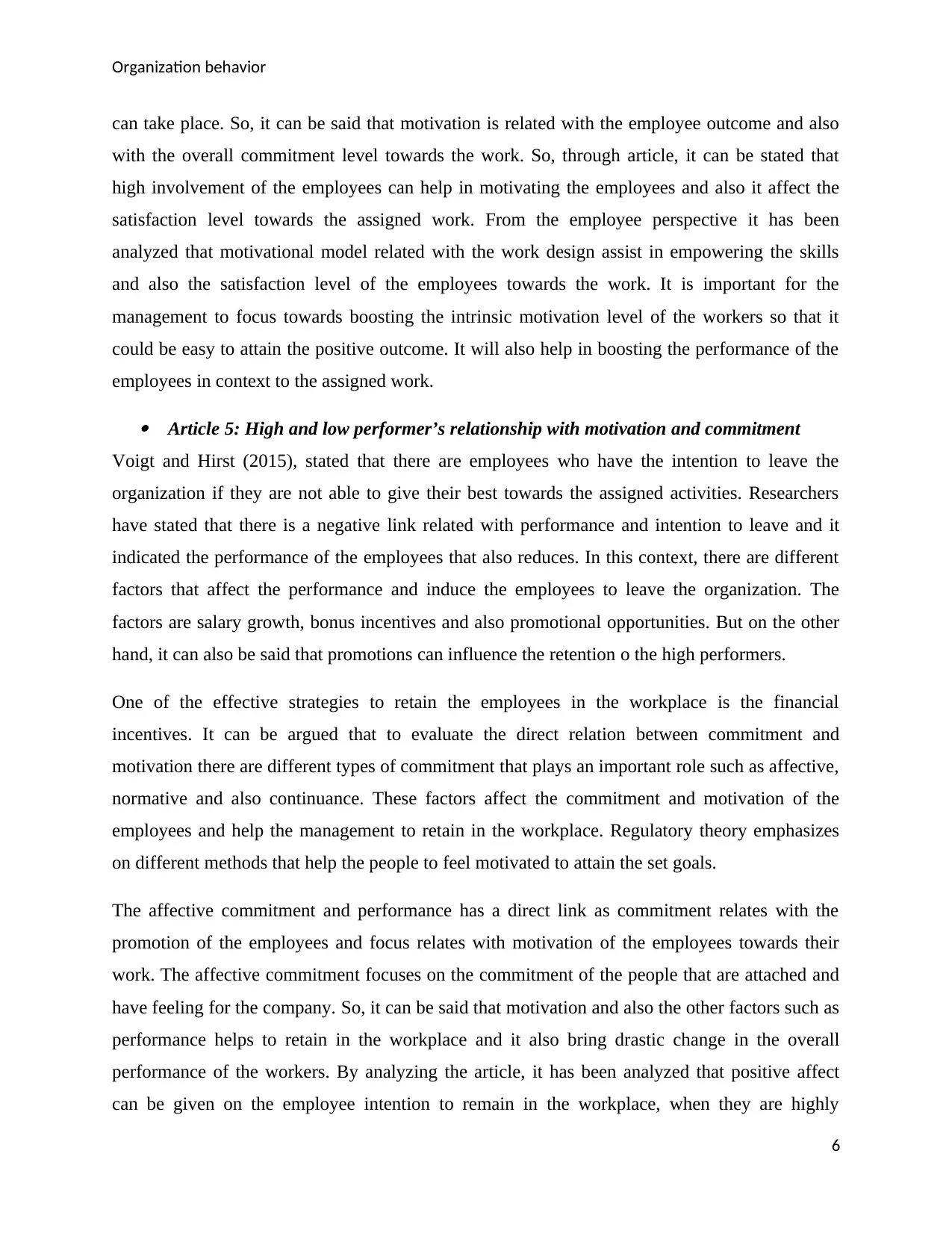
Organization behavior
can take place. So, it can be said that motivation is related with the employee outcome and also
with the overall commitment level towards the work. So, through article, it can be stated that
high involvement of the employees can help in motivating the employees and also it affect the
satisfaction level towards the assigned work. From the employee perspective it has been
analyzed that motivational model related with the work design assist in empowering the skills
and also the satisfaction level of the employees towards the work. It is important for the
management to focus towards boosting the intrinsic motivation level of the workers so that it
could be easy to attain the positive outcome. It will also help in boosting the performance of the
employees in context to the assigned work.
Article 5: High and low performer’s relationship with motivation and commitment
Voigt and Hirst (2015), stated that there are employees who have the intention to leave the
organization if they are not able to give their best towards the assigned activities. Researchers
have stated that there is a negative link related with performance and intention to leave and it
indicated the performance of the employees that also reduces. In this context, there are different
factors that affect the performance and induce the employees to leave the organization. The
factors are salary growth, bonus incentives and also promotional opportunities. But on the other
hand, it can also be said that promotions can influence the retention o the high performers.
One of the effective strategies to retain the employees in the workplace is the financial
incentives. It can be argued that to evaluate the direct relation between commitment and
motivation there are different types of commitment that plays an important role such as affective,
normative and also continuance. These factors affect the commitment and motivation of the
employees and help the management to retain in the workplace. Regulatory theory emphasizes
on different methods that help the people to feel motivated to attain the set goals.
The affective commitment and performance has a direct link as commitment relates with the
promotion of the employees and focus relates with motivation of the employees towards their
work. The affective commitment focuses on the commitment of the people that are attached and
have feeling for the company. So, it can be said that motivation and also the other factors such as
performance helps to retain in the workplace and it also bring drastic change in the overall
performance of the workers. By analyzing the article, it has been analyzed that positive affect
can be given on the employee intention to remain in the workplace, when they are highly
6
can take place. So, it can be said that motivation is related with the employee outcome and also
with the overall commitment level towards the work. So, through article, it can be stated that
high involvement of the employees can help in motivating the employees and also it affect the
satisfaction level towards the assigned work. From the employee perspective it has been
analyzed that motivational model related with the work design assist in empowering the skills
and also the satisfaction level of the employees towards the work. It is important for the
management to focus towards boosting the intrinsic motivation level of the workers so that it
could be easy to attain the positive outcome. It will also help in boosting the performance of the
employees in context to the assigned work.
Article 5: High and low performer’s relationship with motivation and commitment
Voigt and Hirst (2015), stated that there are employees who have the intention to leave the
organization if they are not able to give their best towards the assigned activities. Researchers
have stated that there is a negative link related with performance and intention to leave and it
indicated the performance of the employees that also reduces. In this context, there are different
factors that affect the performance and induce the employees to leave the organization. The
factors are salary growth, bonus incentives and also promotional opportunities. But on the other
hand, it can also be said that promotions can influence the retention o the high performers.
One of the effective strategies to retain the employees in the workplace is the financial
incentives. It can be argued that to evaluate the direct relation between commitment and
motivation there are different types of commitment that plays an important role such as affective,
normative and also continuance. These factors affect the commitment and motivation of the
employees and help the management to retain in the workplace. Regulatory theory emphasizes
on different methods that help the people to feel motivated to attain the set goals.
The affective commitment and performance has a direct link as commitment relates with the
promotion of the employees and focus relates with motivation of the employees towards their
work. The affective commitment focuses on the commitment of the people that are attached and
have feeling for the company. So, it can be said that motivation and also the other factors such as
performance helps to retain in the workplace and it also bring drastic change in the overall
performance of the workers. By analyzing the article, it has been analyzed that positive affect
can be given on the employee intention to remain in the workplace, when they are highly
6
⊘ This is a preview!⊘
Do you want full access?
Subscribe today to unlock all pages.

Trusted by 1+ million students worldwide
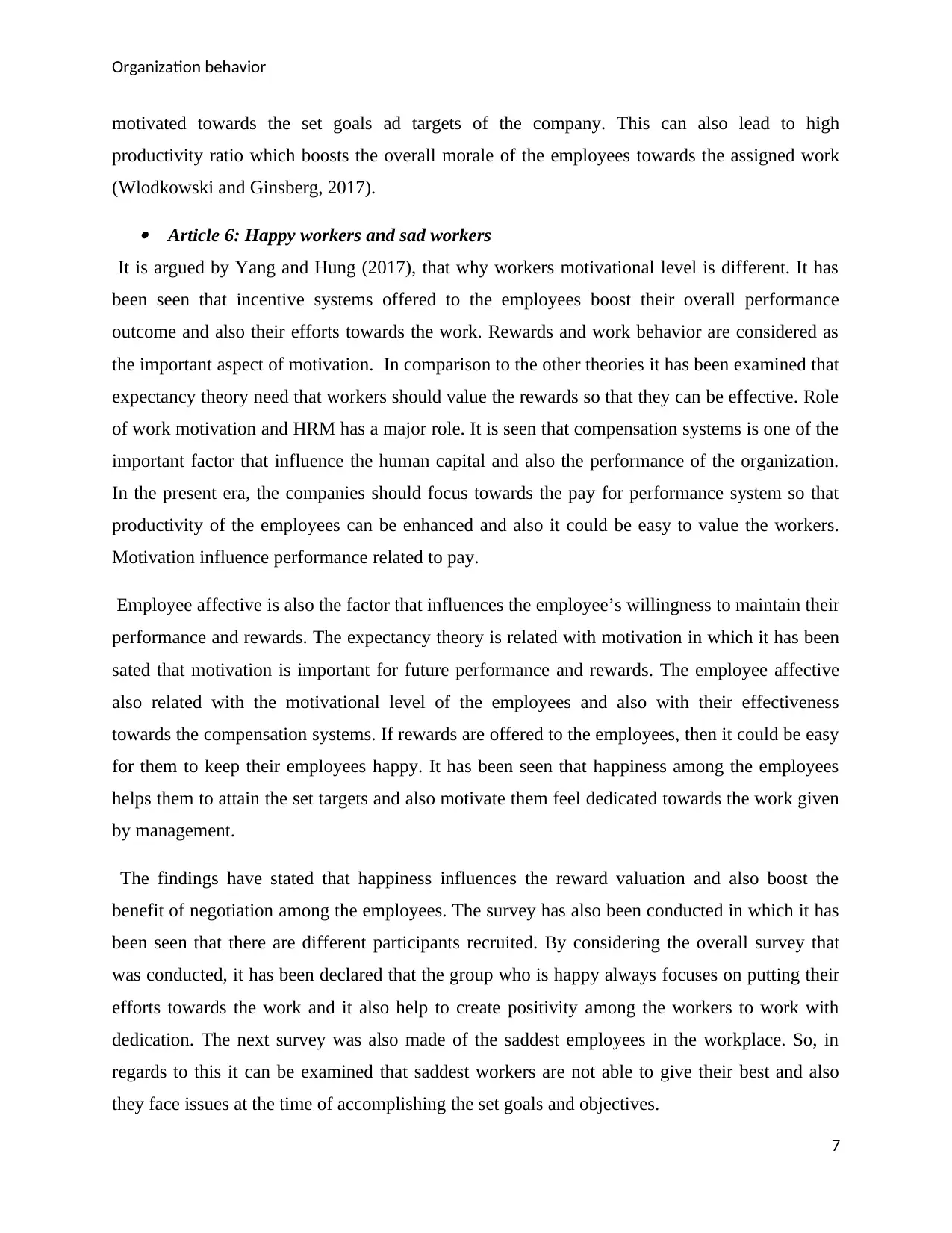
Organization behavior
motivated towards the set goals ad targets of the company. This can also lead to high
productivity ratio which boosts the overall morale of the employees towards the assigned work
(Wlodkowski and Ginsberg, 2017).
Article 6: Happy workers and sad workers
It is argued by Yang and Hung (2017), that why workers motivational level is different. It has
been seen that incentive systems offered to the employees boost their overall performance
outcome and also their efforts towards the work. Rewards and work behavior are considered as
the important aspect of motivation. In comparison to the other theories it has been examined that
expectancy theory need that workers should value the rewards so that they can be effective. Role
of work motivation and HRM has a major role. It is seen that compensation systems is one of the
important factor that influence the human capital and also the performance of the organization.
In the present era, the companies should focus towards the pay for performance system so that
productivity of the employees can be enhanced and also it could be easy to value the workers.
Motivation influence performance related to pay.
Employee affective is also the factor that influences the employee’s willingness to maintain their
performance and rewards. The expectancy theory is related with motivation in which it has been
sated that motivation is important for future performance and rewards. The employee affective
also related with the motivational level of the employees and also with their effectiveness
towards the compensation systems. If rewards are offered to the employees, then it could be easy
for them to keep their employees happy. It has been seen that happiness among the employees
helps them to attain the set targets and also motivate them feel dedicated towards the work given
by management.
The findings have stated that happiness influences the reward valuation and also boost the
benefit of negotiation among the employees. The survey has also been conducted in which it has
been seen that there are different participants recruited. By considering the overall survey that
was conducted, it has been declared that the group who is happy always focuses on putting their
efforts towards the work and it also help to create positivity among the workers to work with
dedication. The next survey was also made of the saddest employees in the workplace. So, in
regards to this it can be examined that saddest workers are not able to give their best and also
they face issues at the time of accomplishing the set goals and objectives.
7
motivated towards the set goals ad targets of the company. This can also lead to high
productivity ratio which boosts the overall morale of the employees towards the assigned work
(Wlodkowski and Ginsberg, 2017).
Article 6: Happy workers and sad workers
It is argued by Yang and Hung (2017), that why workers motivational level is different. It has
been seen that incentive systems offered to the employees boost their overall performance
outcome and also their efforts towards the work. Rewards and work behavior are considered as
the important aspect of motivation. In comparison to the other theories it has been examined that
expectancy theory need that workers should value the rewards so that they can be effective. Role
of work motivation and HRM has a major role. It is seen that compensation systems is one of the
important factor that influence the human capital and also the performance of the organization.
In the present era, the companies should focus towards the pay for performance system so that
productivity of the employees can be enhanced and also it could be easy to value the workers.
Motivation influence performance related to pay.
Employee affective is also the factor that influences the employee’s willingness to maintain their
performance and rewards. The expectancy theory is related with motivation in which it has been
sated that motivation is important for future performance and rewards. The employee affective
also related with the motivational level of the employees and also with their effectiveness
towards the compensation systems. If rewards are offered to the employees, then it could be easy
for them to keep their employees happy. It has been seen that happiness among the employees
helps them to attain the set targets and also motivate them feel dedicated towards the work given
by management.
The findings have stated that happiness influences the reward valuation and also boost the
benefit of negotiation among the employees. The survey has also been conducted in which it has
been seen that there are different participants recruited. By considering the overall survey that
was conducted, it has been declared that the group who is happy always focuses on putting their
efforts towards the work and it also help to create positivity among the workers to work with
dedication. The next survey was also made of the saddest employees in the workplace. So, in
regards to this it can be examined that saddest workers are not able to give their best and also
they face issues at the time of accomplishing the set goals and objectives.
7
Paraphrase This Document
Need a fresh take? Get an instant paraphrase of this document with our AI Paraphraser
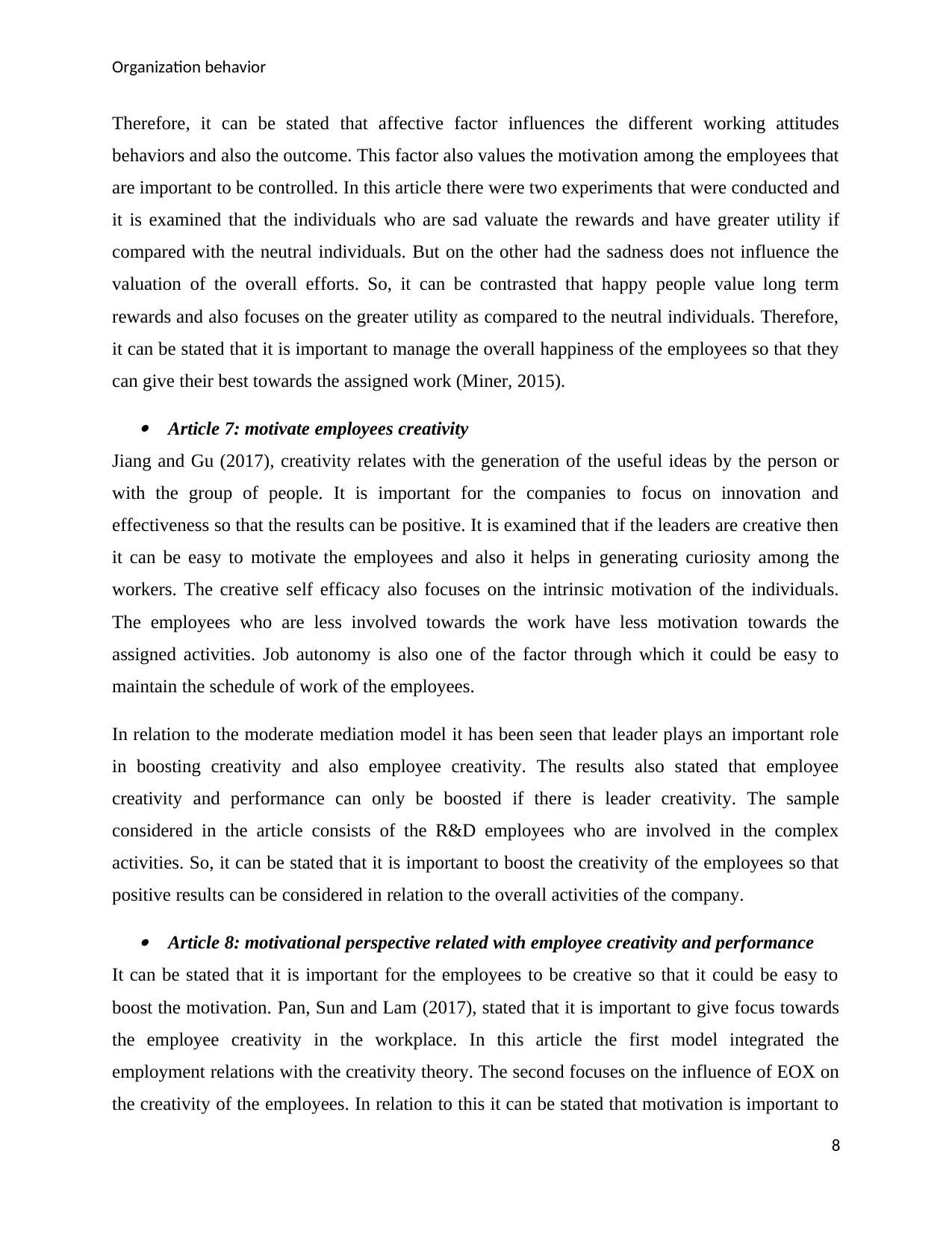
Organization behavior
Therefore, it can be stated that affective factor influences the different working attitudes
behaviors and also the outcome. This factor also values the motivation among the employees that
are important to be controlled. In this article there were two experiments that were conducted and
it is examined that the individuals who are sad valuate the rewards and have greater utility if
compared with the neutral individuals. But on the other had the sadness does not influence the
valuation of the overall efforts. So, it can be contrasted that happy people value long term
rewards and also focuses on the greater utility as compared to the neutral individuals. Therefore,
it can be stated that it is important to manage the overall happiness of the employees so that they
can give their best towards the assigned work (Miner, 2015).
Article 7: motivate employees creativity
Jiang and Gu (2017), creativity relates with the generation of the useful ideas by the person or
with the group of people. It is important for the companies to focus on innovation and
effectiveness so that the results can be positive. It is examined that if the leaders are creative then
it can be easy to motivate the employees and also it helps in generating curiosity among the
workers. The creative self efficacy also focuses on the intrinsic motivation of the individuals.
The employees who are less involved towards the work have less motivation towards the
assigned activities. Job autonomy is also one of the factor through which it could be easy to
maintain the schedule of work of the employees.
In relation to the moderate mediation model it has been seen that leader plays an important role
in boosting creativity and also employee creativity. The results also stated that employee
creativity and performance can only be boosted if there is leader creativity. The sample
considered in the article consists of the R&D employees who are involved in the complex
activities. So, it can be stated that it is important to boost the creativity of the employees so that
positive results can be considered in relation to the overall activities of the company.
Article 8: motivational perspective related with employee creativity and performance
It can be stated that it is important for the employees to be creative so that it could be easy to
boost the motivation. Pan, Sun and Lam (2017), stated that it is important to give focus towards
the employee creativity in the workplace. In this article the first model integrated the
employment relations with the creativity theory. The second focuses on the influence of EOX on
the creativity of the employees. In relation to this it can be stated that motivation is important to
8
Therefore, it can be stated that affective factor influences the different working attitudes
behaviors and also the outcome. This factor also values the motivation among the employees that
are important to be controlled. In this article there were two experiments that were conducted and
it is examined that the individuals who are sad valuate the rewards and have greater utility if
compared with the neutral individuals. But on the other had the sadness does not influence the
valuation of the overall efforts. So, it can be contrasted that happy people value long term
rewards and also focuses on the greater utility as compared to the neutral individuals. Therefore,
it can be stated that it is important to manage the overall happiness of the employees so that they
can give their best towards the assigned work (Miner, 2015).
Article 7: motivate employees creativity
Jiang and Gu (2017), creativity relates with the generation of the useful ideas by the person or
with the group of people. It is important for the companies to focus on innovation and
effectiveness so that the results can be positive. It is examined that if the leaders are creative then
it can be easy to motivate the employees and also it helps in generating curiosity among the
workers. The creative self efficacy also focuses on the intrinsic motivation of the individuals.
The employees who are less involved towards the work have less motivation towards the
assigned activities. Job autonomy is also one of the factor through which it could be easy to
maintain the schedule of work of the employees.
In relation to the moderate mediation model it has been seen that leader plays an important role
in boosting creativity and also employee creativity. The results also stated that employee
creativity and performance can only be boosted if there is leader creativity. The sample
considered in the article consists of the R&D employees who are involved in the complex
activities. So, it can be stated that it is important to boost the creativity of the employees so that
positive results can be considered in relation to the overall activities of the company.
Article 8: motivational perspective related with employee creativity and performance
It can be stated that it is important for the employees to be creative so that it could be easy to
boost the motivation. Pan, Sun and Lam (2017), stated that it is important to give focus towards
the employee creativity in the workplace. In this article the first model integrated the
employment relations with the creativity theory. The second focuses on the influence of EOX on
the creativity of the employees. In relation to this it can be stated that motivation is important to
8
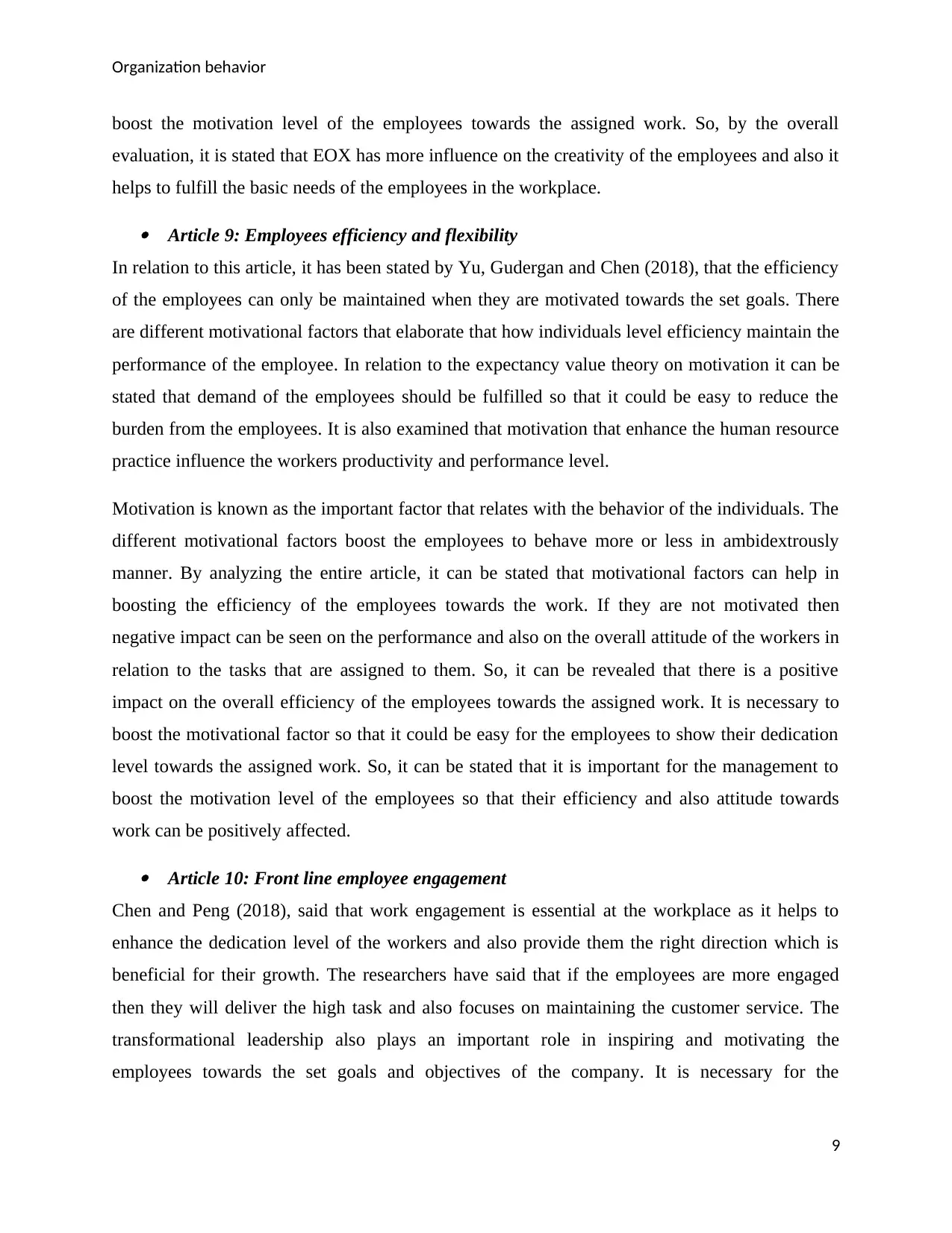
Organization behavior
boost the motivation level of the employees towards the assigned work. So, by the overall
evaluation, it is stated that EOX has more influence on the creativity of the employees and also it
helps to fulfill the basic needs of the employees in the workplace.
Article 9: Employees efficiency and flexibility
In relation to this article, it has been stated by Yu, Gudergan and Chen (2018), that the efficiency
of the employees can only be maintained when they are motivated towards the set goals. There
are different motivational factors that elaborate that how individuals level efficiency maintain the
performance of the employee. In relation to the expectancy value theory on motivation it can be
stated that demand of the employees should be fulfilled so that it could be easy to reduce the
burden from the employees. It is also examined that motivation that enhance the human resource
practice influence the workers productivity and performance level.
Motivation is known as the important factor that relates with the behavior of the individuals. The
different motivational factors boost the employees to behave more or less in ambidextrously
manner. By analyzing the entire article, it can be stated that motivational factors can help in
boosting the efficiency of the employees towards the work. If they are not motivated then
negative impact can be seen on the performance and also on the overall attitude of the workers in
relation to the tasks that are assigned to them. So, it can be revealed that there is a positive
impact on the overall efficiency of the employees towards the assigned work. It is necessary to
boost the motivational factor so that it could be easy for the employees to show their dedication
level towards the assigned work. So, it can be stated that it is important for the management to
boost the motivation level of the employees so that their efficiency and also attitude towards
work can be positively affected.
Article 10: Front line employee engagement
Chen and Peng (2018), said that work engagement is essential at the workplace as it helps to
enhance the dedication level of the workers and also provide them the right direction which is
beneficial for their growth. The researchers have said that if the employees are more engaged
then they will deliver the high task and also focuses on maintaining the customer service. The
transformational leadership also plays an important role in inspiring and motivating the
employees towards the set goals and objectives of the company. It is necessary for the
9
boost the motivation level of the employees towards the assigned work. So, by the overall
evaluation, it is stated that EOX has more influence on the creativity of the employees and also it
helps to fulfill the basic needs of the employees in the workplace.
Article 9: Employees efficiency and flexibility
In relation to this article, it has been stated by Yu, Gudergan and Chen (2018), that the efficiency
of the employees can only be maintained when they are motivated towards the set goals. There
are different motivational factors that elaborate that how individuals level efficiency maintain the
performance of the employee. In relation to the expectancy value theory on motivation it can be
stated that demand of the employees should be fulfilled so that it could be easy to reduce the
burden from the employees. It is also examined that motivation that enhance the human resource
practice influence the workers productivity and performance level.
Motivation is known as the important factor that relates with the behavior of the individuals. The
different motivational factors boost the employees to behave more or less in ambidextrously
manner. By analyzing the entire article, it can be stated that motivational factors can help in
boosting the efficiency of the employees towards the work. If they are not motivated then
negative impact can be seen on the performance and also on the overall attitude of the workers in
relation to the tasks that are assigned to them. So, it can be revealed that there is a positive
impact on the overall efficiency of the employees towards the assigned work. It is necessary to
boost the motivational factor so that it could be easy for the employees to show their dedication
level towards the assigned work. So, it can be stated that it is important for the management to
boost the motivation level of the employees so that their efficiency and also attitude towards
work can be positively affected.
Article 10: Front line employee engagement
Chen and Peng (2018), said that work engagement is essential at the workplace as it helps to
enhance the dedication level of the workers and also provide them the right direction which is
beneficial for their growth. The researchers have said that if the employees are more engaged
then they will deliver the high task and also focuses on maintaining the customer service. The
transformational leadership also plays an important role in inspiring and motivating the
employees towards the set goals and objectives of the company. It is necessary for the
9
⊘ This is a preview!⊘
Do you want full access?
Subscribe today to unlock all pages.

Trusted by 1+ million students worldwide
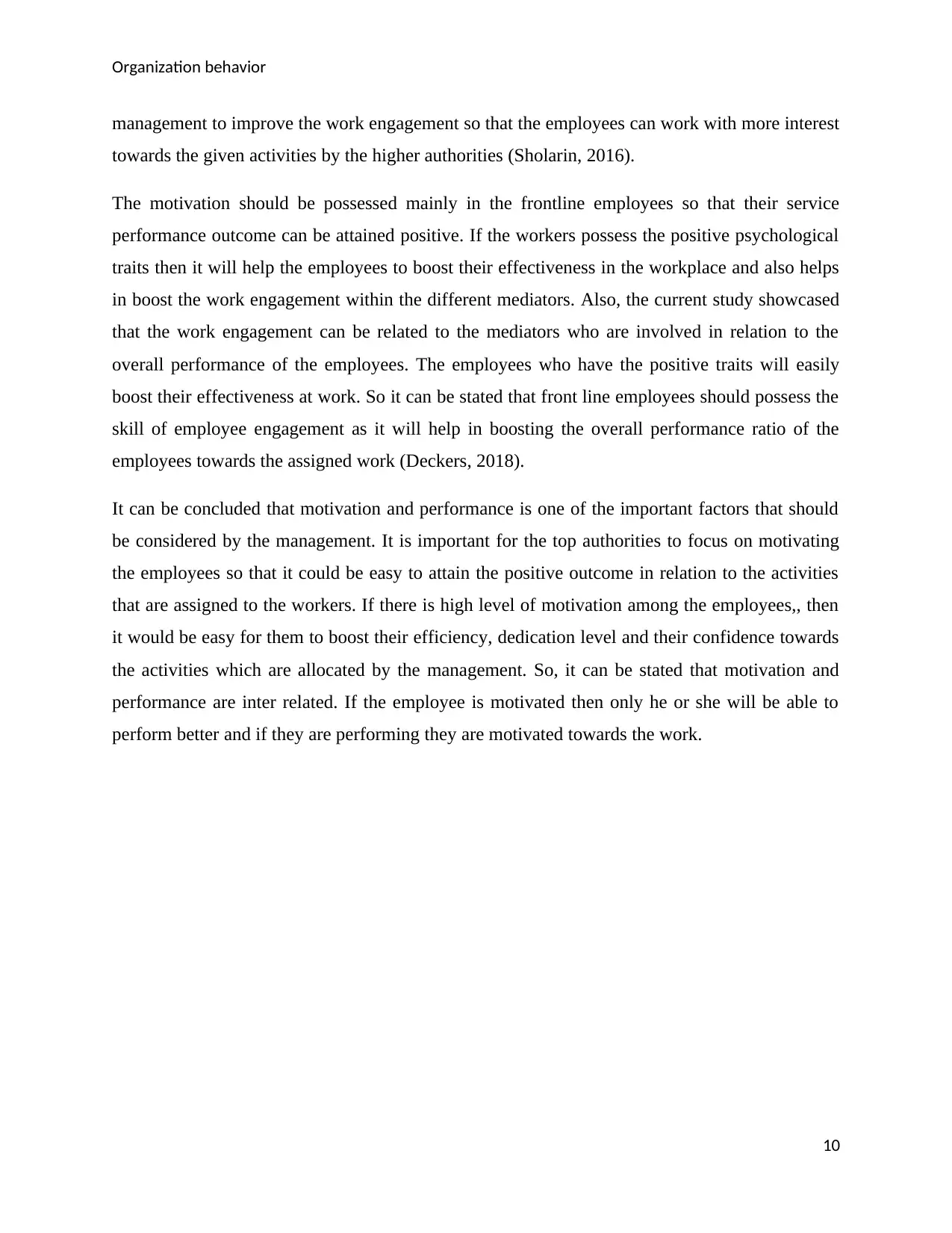
Organization behavior
management to improve the work engagement so that the employees can work with more interest
towards the given activities by the higher authorities (Sholarin, 2016).
The motivation should be possessed mainly in the frontline employees so that their service
performance outcome can be attained positive. If the workers possess the positive psychological
traits then it will help the employees to boost their effectiveness in the workplace and also helps
in boost the work engagement within the different mediators. Also, the current study showcased
that the work engagement can be related to the mediators who are involved in relation to the
overall performance of the employees. The employees who have the positive traits will easily
boost their effectiveness at work. So it can be stated that front line employees should possess the
skill of employee engagement as it will help in boosting the overall performance ratio of the
employees towards the assigned work (Deckers, 2018).
It can be concluded that motivation and performance is one of the important factors that should
be considered by the management. It is important for the top authorities to focus on motivating
the employees so that it could be easy to attain the positive outcome in relation to the activities
that are assigned to the workers. If there is high level of motivation among the employees,, then
it would be easy for them to boost their efficiency, dedication level and their confidence towards
the activities which are allocated by the management. So, it can be stated that motivation and
performance are inter related. If the employee is motivated then only he or she will be able to
perform better and if they are performing they are motivated towards the work.
10
management to improve the work engagement so that the employees can work with more interest
towards the given activities by the higher authorities (Sholarin, 2016).
The motivation should be possessed mainly in the frontline employees so that their service
performance outcome can be attained positive. If the workers possess the positive psychological
traits then it will help the employees to boost their effectiveness in the workplace and also helps
in boost the work engagement within the different mediators. Also, the current study showcased
that the work engagement can be related to the mediators who are involved in relation to the
overall performance of the employees. The employees who have the positive traits will easily
boost their effectiveness at work. So it can be stated that front line employees should possess the
skill of employee engagement as it will help in boosting the overall performance ratio of the
employees towards the assigned work (Deckers, 2018).
It can be concluded that motivation and performance is one of the important factors that should
be considered by the management. It is important for the top authorities to focus on motivating
the employees so that it could be easy to attain the positive outcome in relation to the activities
that are assigned to the workers. If there is high level of motivation among the employees,, then
it would be easy for them to boost their efficiency, dedication level and their confidence towards
the activities which are allocated by the management. So, it can be stated that motivation and
performance are inter related. If the employee is motivated then only he or she will be able to
perform better and if they are performing they are motivated towards the work.
10
Paraphrase This Document
Need a fresh take? Get an instant paraphrase of this document with our AI Paraphraser
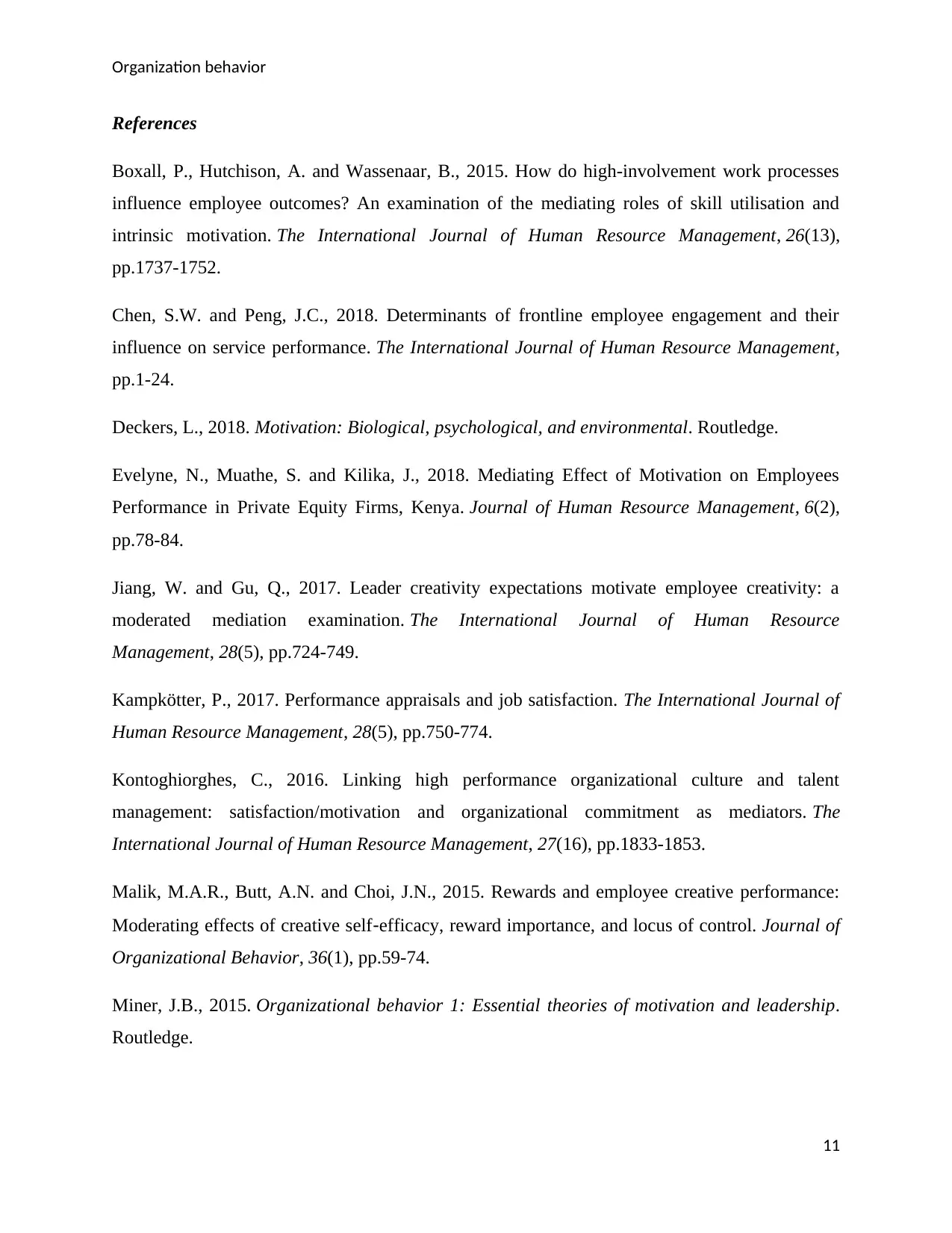
Organization behavior
References
Boxall, P., Hutchison, A. and Wassenaar, B., 2015. How do high-involvement work processes
influence employee outcomes? An examination of the mediating roles of skill utilisation and
intrinsic motivation. The International Journal of Human Resource Management, 26(13),
pp.1737-1752.
Chen, S.W. and Peng, J.C., 2018. Determinants of frontline employee engagement and their
influence on service performance. The International Journal of Human Resource Management,
pp.1-24.
Deckers, L., 2018. Motivation: Biological, psychological, and environmental. Routledge.
Evelyne, N., Muathe, S. and Kilika, J., 2018. Mediating Effect of Motivation on Employees
Performance in Private Equity Firms, Kenya. Journal of Human Resource Management, 6(2),
pp.78-84.
Jiang, W. and Gu, Q., 2017. Leader creativity expectations motivate employee creativity: a
moderated mediation examination. The International Journal of Human Resource
Management, 28(5), pp.724-749.
Kampkötter, P., 2017. Performance appraisals and job satisfaction. The International Journal of
Human Resource Management, 28(5), pp.750-774.
Kontoghiorghes, C., 2016. Linking high performance organizational culture and talent
management: satisfaction/motivation and organizational commitment as mediators. The
International Journal of Human Resource Management, 27(16), pp.1833-1853.
Malik, M.A.R., Butt, A.N. and Choi, J.N., 2015. Rewards and employee creative performance:
Moderating effects of creative self‐efficacy, reward importance, and locus of control. Journal of
Organizational Behavior, 36(1), pp.59-74.
Miner, J.B., 2015. Organizational behavior 1: Essential theories of motivation and leadership.
Routledge.
11
References
Boxall, P., Hutchison, A. and Wassenaar, B., 2015. How do high-involvement work processes
influence employee outcomes? An examination of the mediating roles of skill utilisation and
intrinsic motivation. The International Journal of Human Resource Management, 26(13),
pp.1737-1752.
Chen, S.W. and Peng, J.C., 2018. Determinants of frontline employee engagement and their
influence on service performance. The International Journal of Human Resource Management,
pp.1-24.
Deckers, L., 2018. Motivation: Biological, psychological, and environmental. Routledge.
Evelyne, N., Muathe, S. and Kilika, J., 2018. Mediating Effect of Motivation on Employees
Performance in Private Equity Firms, Kenya. Journal of Human Resource Management, 6(2),
pp.78-84.
Jiang, W. and Gu, Q., 2017. Leader creativity expectations motivate employee creativity: a
moderated mediation examination. The International Journal of Human Resource
Management, 28(5), pp.724-749.
Kampkötter, P., 2017. Performance appraisals and job satisfaction. The International Journal of
Human Resource Management, 28(5), pp.750-774.
Kontoghiorghes, C., 2016. Linking high performance organizational culture and talent
management: satisfaction/motivation and organizational commitment as mediators. The
International Journal of Human Resource Management, 27(16), pp.1833-1853.
Malik, M.A.R., Butt, A.N. and Choi, J.N., 2015. Rewards and employee creative performance:
Moderating effects of creative self‐efficacy, reward importance, and locus of control. Journal of
Organizational Behavior, 36(1), pp.59-74.
Miner, J.B., 2015. Organizational behavior 1: Essential theories of motivation and leadership.
Routledge.
11
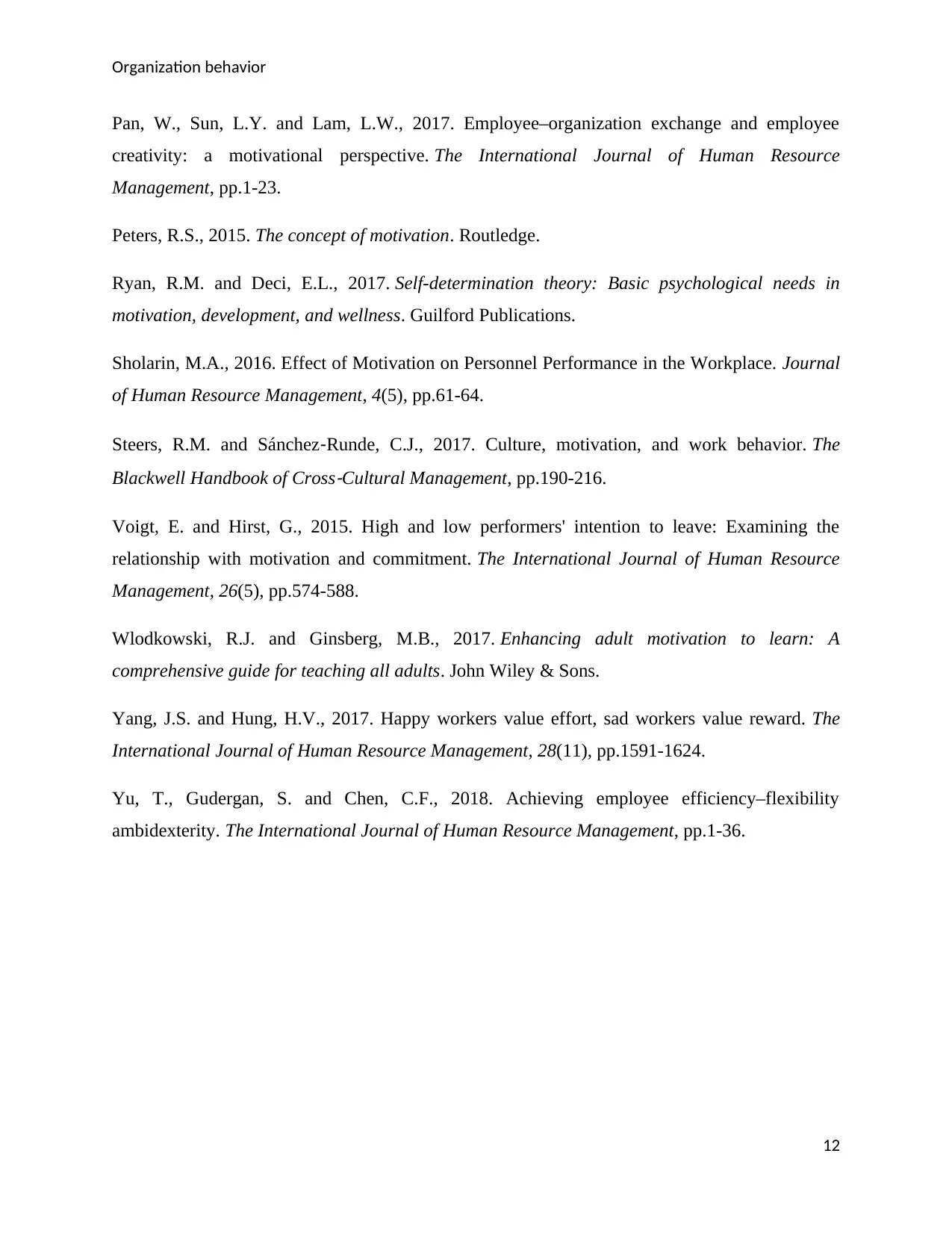
Organization behavior
Pan, W., Sun, L.Y. and Lam, L.W., 2017. Employee–organization exchange and employee
creativity: a motivational perspective. The International Journal of Human Resource
Management, pp.1-23.
Peters, R.S., 2015. The concept of motivation. Routledge.
Ryan, R.M. and Deci, E.L., 2017. Self-determination theory: Basic psychological needs in
motivation, development, and wellness. Guilford Publications.
Sholarin, M.A., 2016. Effect of Motivation on Personnel Performance in the Workplace. Journal
of Human Resource Management, 4(5), pp.61-64.
Steers, R.M. and Sánchez‐Runde, C.J., 2017. Culture, motivation, and work behavior. The
Blackwell Handbook of Cross
‐Cultural Management, pp.190-216.
Voigt, E. and Hirst, G., 2015. High and low performers' intention to leave: Examining the
relationship with motivation and commitment. The International Journal of Human Resource
Management, 26(5), pp.574-588.
Wlodkowski, R.J. and Ginsberg, M.B., 2017. Enhancing adult motivation to learn: A
comprehensive guide for teaching all adults. John Wiley & Sons.
Yang, J.S. and Hung, H.V., 2017. Happy workers value effort, sad workers value reward. The
International Journal of Human Resource Management, 28(11), pp.1591-1624.
Yu, T., Gudergan, S. and Chen, C.F., 2018. Achieving employee efficiency–flexibility
ambidexterity. The International Journal of Human Resource Management, pp.1-36.
12
Pan, W., Sun, L.Y. and Lam, L.W., 2017. Employee–organization exchange and employee
creativity: a motivational perspective. The International Journal of Human Resource
Management, pp.1-23.
Peters, R.S., 2015. The concept of motivation. Routledge.
Ryan, R.M. and Deci, E.L., 2017. Self-determination theory: Basic psychological needs in
motivation, development, and wellness. Guilford Publications.
Sholarin, M.A., 2016. Effect of Motivation on Personnel Performance in the Workplace. Journal
of Human Resource Management, 4(5), pp.61-64.
Steers, R.M. and Sánchez‐Runde, C.J., 2017. Culture, motivation, and work behavior. The
Blackwell Handbook of Cross
‐Cultural Management, pp.190-216.
Voigt, E. and Hirst, G., 2015. High and low performers' intention to leave: Examining the
relationship with motivation and commitment. The International Journal of Human Resource
Management, 26(5), pp.574-588.
Wlodkowski, R.J. and Ginsberg, M.B., 2017. Enhancing adult motivation to learn: A
comprehensive guide for teaching all adults. John Wiley & Sons.
Yang, J.S. and Hung, H.V., 2017. Happy workers value effort, sad workers value reward. The
International Journal of Human Resource Management, 28(11), pp.1591-1624.
Yu, T., Gudergan, S. and Chen, C.F., 2018. Achieving employee efficiency–flexibility
ambidexterity. The International Journal of Human Resource Management, pp.1-36.
12
⊘ This is a preview!⊘
Do you want full access?
Subscribe today to unlock all pages.

Trusted by 1+ million students worldwide
1 out of 12
Related Documents
Your All-in-One AI-Powered Toolkit for Academic Success.
+13062052269
info@desklib.com
Available 24*7 on WhatsApp / Email
![[object Object]](/_next/static/media/star-bottom.7253800d.svg)
Unlock your academic potential
Copyright © 2020–2025 A2Z Services. All Rights Reserved. Developed and managed by ZUCOL.





